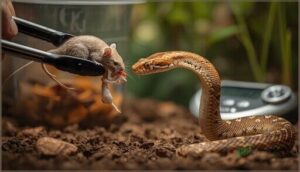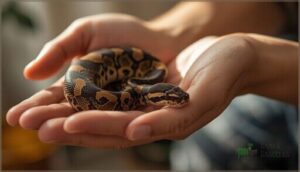This site is supported by our readers. We may earn a commission, at no cost to you, if you purchase through links.
Most first-time snake owners underestimate how much their setup decisions affect long-term health outcomes. A corn snake in a poorly ventilated glass tank with improper temperature gradients won’t just seem uncomfortable—it’ll face respiratory infections, feeding refusal, and shortened lifespan.
The difference between a thriving snake and one that merely survives comes down to understanding species-specific needs before you bring your new pet home. When you care for pet snake species correctly, you’re not just following a care sheet—you’re replicating the environmental conditions that allow these animals to express natural behaviors and maintain physiological health.
Getting the fundamentals right from day one means fewer veterinary emergencies, lower stress for both you and your snake, and the satisfaction of watching a well-adapted animal thrive in captivity.
Table Of Contents
- Key Takeaways
- Choosing The Right Pet Snake Species
- Setting Up a Suitable Snake Habitat
- Creating a Naturalistic Snake Environment
- Feeding and Nutrition for Pet Snakes
- Maintaining Snake Health and Hygiene
- Safe Handling and Interaction Techniques
- Enrichment and Welfare for Pet Snakes
- Frequently Asked Questions (FAQs)
- Conclusion
Key Takeaways
- Your snake’s long-term health hinges on replicating species-specific environmental conditions—proper temperature gradients, humidity levels, and enclosure dimensions aren’t suggestions, they’re physiological requirements that directly prevent respiratory infections, feeding refusal, and shortened lifespans.
- Beginner-friendly species like corn snakes and ball pythons forgive mistakes while you learn, but choosing a snake based on aesthetics rather than your experience level, available space, and commitment capacity sets you up for veterinary emergencies and welfare failures.
- Daily spot cleaning, weekly disinfection, and consistent monitoring for behavioral changes catch diseases before they become life-threatening—only 42% of reptile owners provide routine veterinary care, yet early detection dramatically improves recovery rates from parasitic infections and respiratory disease.
- Environmental enrichment through hide rotation, climbing structures, and thermal gradients isn’t optional luxury—it’s essential for cognitive development, natural behavior expression, and preventing the repetitive stress behaviors that signal declining welfare in captive snakes.
Choosing The Right Pet Snake Species
Choosing your first snake isn’t about picking the prettiest pattern—it’s about matching a species to your experience level, available space, and commitment capacity. Some snakes will forgive beginner mistakes while others demand precision from day one.
Your first snake choice should match your skill level and space, not just the pattern you find prettiest
Let’s break down what separates a manageable starter species from one that’ll test even experienced keepers.
Beginner-Friendly Snake Species
Choosing the right pet snake starts with understanding breed variations that match your commitment level. Corn snakes account for 35% of beginner-friendly snakes worldwide—their manageable 3–5 foot size and 98% acceptance of frozen prey make snake care straightforward. Ball pythons and kingsnakes offer similar reliability in snake handling and reptile nutrition.
These species let you focus on proper snake behavior observation, not survival struggles, with pet snake costs starting around $40–$70. For more information on pet snakes, consider researching low maintenance pets to find the best fit.
Factors to Consider Before Choosing
Once you’ve identified docile breeds for pet snakes, selecting the right pet snake species demands careful breed research aligned with your lifestyle. Space requirements scale dramatically—larger constrictors need enclosures exceeding their body length, while colubrids thrive in more compact setups. Snake temperament, owner experience level, and cost factors all influence long-term success in reptile husbandry and snake care commitment. Understanding proper thermal gradient controls is vital for maintaining a healthy environment.
Consider these decision-making factors:
- Adult Size – Species mature from 3 feet to over 10 feet
- Lifespan – Commitment spans 15–30+ years depending on species
- Temperature and Humidity Needs – Ball pythons require 50–75% humidity; corn snakes need 40–60%
- Feeding Requirements – Prey size, frequency, and hunting behavior vary notably
- Activity Level – Active species demand more enrichment and behavioral stimulation
Avoiding Venomous and High-Maintenance Species
Beyond suitability, responsible ownership means steering clear of venomous species and high-maintenance breeds that compromise safety and welfare. Fewer than 500 of 3,000 snake species are venomous, yet legal restrictions ban private ownership in most jurisdictions—penalties include confiscation and permanent license revocation. Burmese pythons, rock pythons, and green tree pythons demand complex reptile husbandry protocols unsuitable for most keepers.
| Species Type | Primary Risk Factor |
|---|---|
| Venomous (rattlesnakes, coral snakes) | Life-threatening envenomation requiring immediate antivenin |
| Large constrictors (Burmese pythons, rock pythons) | Strength, feeding demands, enclosure complexity |
| Specialized arboreal species (green tree pythons) | Precise humidity and thermal gradient requirements |
Understanding snake behavior prevents mismatches. Ball pythons and Kenyan sand boas offer manageable alternatives, while ethical breeders refuse to sell high-maintenance pet snakes to inexperienced buyers. Safety precautions aren’t optional—they’re foundational to snake care.
Sourcing Snakes From Reputable Breeders
After zeroing in on the right species, you’ll want to track down a trustworthy source. Over 80% of pet snakes now come from domestic captive-bred operations, and reputable breeders make all the difference—they prioritize genetic testing, breeding ethics, and permit compliance.
What sets the best apart?
- Health certificates and snake pedigree documentation with every sale
- Transparent facility practices and breeder reputation backed by community reviews
- Active engagement in exotic pet care education and snake care standards
- Permit compliance and documented lineage to guarantee captive-bred snakes meet welfare benchmarks
Legal and Permit Requirements
Before you bring your snake home, you’ll need to navigate a web of regulations. Federal laws like the Lacey Act, state permits for venomous or large constrictors, and local ordinances can all dictate what you’re allowed to keep. Species regulations and import restrictions vary widely—some states blacklist entire genera, while municipalities ban ownership outright. Check all three levels to avoid confiscation, fines, or criminal charges.
| Regulation Level | Common Requirements | Enforcement Actions |
|---|---|---|
| Federal Laws | Import permits, Lacey Act compliance | Interstate transport bans |
| State Permits | Species-specific licenses, annual renewals | Fines exceeding $5,000 |
| Local Ordinances | Registration, home inspections | Forced surrender or removal |
| Species Regulations | Genetic documentation for hybrids | Confiscation of blacklisted species |
| Import Restrictions | Quarantine, health certificates | Border seizure and penalties |
This framework reflects reptile conservation and welfare priorities, wildlife conservation and biology mandates, and animal welfare and ethics standards across jurisdictions.
Exotic pet care and handling responsibilities begin with understanding these legal layers, ensuring your animal care and welfare practices align with every applicable rule.
Setting Up a Suitable Snake Habitat
Your snake’s enclosure isn’t just a box—it’s the foundation of everything from digestion to immune function. Getting the habitat right means understanding how terrarium dimensions, temperature zones, and humidity levels work together to replicate what your snake needs to survive.
Let’s break down the core setup requirements that’ll keep your snake healthy and stress-free.
Selecting The Correct Terrarium Size
Your snake’s enclosure size directly shapes its health and behavior—undersized terrariums restrict movement and increase stress. Adult corn snakes need at least 120 x 60 x 60 cm of habitat dimensions, while ball pythons require 4′ x 2′ x 2′ minimum.
Plan tank upgrades as your snake grows; larger snake enclosures promote natural stretching and activity, with studies confirming higher wellness in spacious setups.
Essential Enclosure Features and Security
Enclosure materials matter—PVC and HDPE models last up to 25 years, outlasting glass aquariums by decades.
Secure locking mechanisms like keyed latches eliminate escape prevention failures, since snakes exploit gaps as small as 0.25 inches.
You’ll need ventilation systems that provide 5–10 air exchanges hourly, reducing respiratory disease risk by over 40%.
Front-opening doors minimize stress during habitat setup adjustments while maintaining proper airflow management throughout your enclosure.
Heating, Lighting, and Temperature Gradients
Your snake’s survival hinges on mastering thermal gradients—the foundation of proper thermoregulation. Use overhead heat sources like halogen bulbs for deep-penetrating infrared, plus a heating pad covering one-third of the tank floor.
Corn snakes need 75–90°F temperature gradients, while ball pythons require basking spots at 88–96°F. UVB exposure (UVI 2.0–3.0) enhances natural behaviors.
Digital thermostats prevent deadly temperature control failures.
Humidity Control and Monitoring
Why do most captive snakes suffer incomplete sheds? You’re overlooking humidity. Digital hygrometers track levels with ±2% accuracy—recalibrate every 3–6 months to prevent drift.
Ball pythons need 50–75% humidity; corn snakes thrive at 40–60%. Use water bowls, misting systems, and humid hides with damp moss.
Proper ventilation—six air exchanges hourly—prevents respiratory infections while maintaining your terrarium’s ideal moisture balance.
Creating a Naturalistic Snake Environment
Your snake’s enclosure isn’t just a box—it’s where your animal will spend its entire life, so getting the details right matters. A well-designed habitat mimics natural conditions, giving your snake the security and stimulation it needs to thrive.
Let’s break down the key components you’ll need to create an environment that fosters both physical health and natural behavior.
Substrate and Furnishing Choices
You’ll make or break your snake’s health with substrate options—aspen shavings suit dry species, while coconut fiber excels for tropical pythons needing humidity control above 60%. Bioactive systems using 40% topsoil, 40% coconut, and 20% sand create self-sustaining terrarium environments.
Choose furnishing materials that enable burrowing and enrichment, avoiding dusty bedding that triggers respiratory issues in your enclosure design.
Providing Hides and Climbing Structures
Beyond substrate, your snake’s psychological health depends on hides and climbing structures—environmental complexity that transforms sterile boxes into functional habitats. Place at least two hides at different temperature zones; snakes using dual-hide setups show 34% fewer defensive postures.
Incorporate climbing materials like cork bark and branches for vertical space enrichment—species with access to elevated structures display 36% more locomotor activity, supporting cognitive development and natural repertoires in your terrarium.
Water Bowls and Bathing Areas
Your snake’s water dish anchors both hydration needs and bathing frequency—choose one large enough for full submersion (roughly 1 inch deep for juveniles) to support snake hygiene during shed cycles. Bowl placement away from heat sources preserves water quality and humidity levels.
- Replace water daily and perform immediate cleanup following waste contamination
- Select heavy, stable dishes to prevent tipping and bacterial colonization
- Monitor bathing frequency; excessive soaking signals husbandry problems requiring correction
Feeding and Nutrition for Pet Snakes
Feeding your snake properly isn’t about guessing—it’s about understanding what your species needs and delivering it consistently. The right prey type, preparation method, and schedule directly impact your snake’s health, growth, and longevity.
Here’s what you need to know to feed with confidence and precision.
Choosing Appropriate Prey Types and Sizes
You need to match prey size to your snake’s widest body diameter—this single metric prevents regurgitation and injury. Hatchlings thrive on 2-6 gram pinky mice, while adults require 21-150 gram rodents depending on species.
Vary your feeding repertoire beyond monotonous single-prey diets: rodents form 85% of most diets, but incorporating birds, fish, or insects every few feedings delivers balanced snake nutrition and prevents long-term deficiencies.
Feeding frequency shifts with age: juveniles eat every 5-7 days, adults every 10-14 days. Power feeding—offering oversized prey—shortens lifespan and increases morbidity rates, so resist the temptation.
| Snake Life Stage | Recommended Prey Weight |
|---|---|
| Hatchlings | 2-6 grams |
| Juveniles | 7-20 grams |
| Medium Adults | 21-50 grams |
| Large Adults | 51-150 grams |
| Breeding Females | Adjusted for energy demand |
Frozen-Thawed Vs. Live Prey
Once you’ve sized your prey correctly, you’ll face the frozen-thawed versus live prey debate—a decision with real consequences.
Frozen-thawed rodents eliminate up to 25% of veterinary visits caused by prey bites, scratches, and eye injuries while preserving complete nutrient retention for 6-12 months.
Live prey stimulates hunting behaviors but demands constant supervision and raises ethical feeding concerns that responsible keepers can’t ignore.
Feeding Schedules by Age and Species
Your pet snake’s feeding intervals shift dramatically as it matures. Hatchlings demand meals every 4–5 days with pinkie mice, while juveniles under 500g require 10–15% of their body weight weekly.
Adult ball pythons shift to 1–2 week schedules; corn snakes settle into 7–10 days.
Species feeding patterns diverge further—boa constrictors stretch to 2–4 weeks between prey selections as age-based diets evolve.
Safe Feeding Practices
Prey selection determines your snake’s long-term health trajectory. Feeding tools like forceps cut handler injury risk by 85%, while killed prey slashes infection rates by half compared to live prey alternatives.
Follow these protocols for ideal snake nutrition:
- Use frozen-thawed rodents warmed to room temperature—acceptance rates jump 25–40% over cold offerings
- Feed in separate enclosures to prevent substrate ingestion, which causes 8% of digestive blockages
- Wait 48 hours post-feeding before handling to reduce regurgitation risk by over 60%
- Sanitize feeding environments after each use to control Salmonella transmission from feeder rodents
Maintaining Snake Health and Hygiene
Keeping your snake healthy isn’t about reacting to problems—it’s about preventing them before they start. A clean enclosure, vigilant monitoring, and proactive veterinary care form the foundation of responsible snake ownership.
Here’s what you need to know to keep your snake thriving for years to come.
Regular Cleaning and Disinfection
You maintain control over your snake’s health through consistent disinfection protocols. Daily spot cleaning removes waste, uneaten food, and shed skin before bacteria flourish.
Weekly disinfection with reptile-safe cleaners eliminates pathogens from surfaces, hides, and water bowls. Substrate replacement every one to three months prevents infection buildup.
Monthly deep cleaning resets the environment while preserving humidity levels. Clean your equipment thoroughly after each use—cross-contamination between enclosures spreads disease faster than you’d expect.
Monitoring for Common Diseases
Respiratory disease manifests through wheezing and open-mouth breathing in 85% of cases—catch it early, and you’ll avoid that grim 25% mortality rate.
Watch for skin infections presenting as fluid-filled blisters, especially in overly moist conditions.
Parasite control starts with annual fecal analysis, detecting asymptomatic infections in 14% of healthy-appearing snakes.
Persistent anorexia beyond three weeks signals underlying disease in 18% of cases. Nutritional deficiency and common snake health problems demand immediate veterinary care for disease prevention.
Supporting Proper Shedding and Skin Health
Ecdysis dysfunction compromises reptile health and hygiene faster than most owners realize. Humidity control between 50-60% is essential, with localized boosts during the pre-shed phase. Mulch substrates retain moisture better than newspaper, reducing scale health issues and skin infections.
Commercial shedding aids containing vitamin E support skin hydration when applied monthly. Proper water access prevents 90% of shedding complications—your snake’s skin literally depends on it.
Importance of Routine Veterinary Care
Annual veterinary checkups aren’t optional—they’re your snake’s lifeline. Only 42% of reptile owners provide routine care, yet health monitoring catches subclinical parasitic infections and respiratory disease before symptoms appear. Your vet visit should include:
- Complete physical examination for lumps or dehydration
- Fecal analysis for parasite control
- Disease prevention protocols
- Husbandry assessment and medical interventions
Early detection dramatically improves recovery rates in reptile health and wellness.
Safe Handling and Interaction Techniques
Handling your snake isn’t just about picking it up—it’s about reading its cues, respecting its boundaries, and building trust over time. The wrong approach can stress your snake out or put you at risk, while the right techniques create a calm, predictable routine that benefits both of you.
Here’s what you need to know to handle your snake safely and keep the interaction low-stress for everyone involved.
Proper Snake Handling Methods
Handling techniques separate confident keepers from nervous ones. Support your snake’s mid-body while letting it move hand to hand—never grip tightly behind the head unless absolutely necessary. Slow, deliberate movements prevent defensive behavior, since over 85% of non-venomous bites stem from sudden gestures.
For safe handling, especially with larger or venomous species, professional-grade tools make all the difference.
| Tool | Primary Use | Safety Benefit |
|---|---|---|
| Snake hooks | Non-intrusive movement and support | Maintains safe distance during positioning |
| Tongs | Managing defensive or venomous species | Used in 90%+ of venomous handling cases |
| Restraint tubes | Veterinary exams and medication | Immobilizes safely without injury risk |
| Cloth bags | Secure transport or temporary containment | Prevents escape and reduces bite incidents |
| Lock-top containers | Long-term housing and cleaning safety | Eliminates accidental contact or escape |
Reducing Stress During Handling
Beyond mastering handling techniques, stress reduction demands attention to timing and environment. Keep sessions under 15 minutes and limit them to two or three times weekly—overhandling triggers appetite loss and chronic hiding.
Work in quiet, softly lit spaces where familiar scents remain constant. Let your snake exit voluntarily when possible; forced removal spikes defensive behaviors by over 40%.
Consistent, brief contact builds tolerance while respecting their physiological limits.
Understanding Snake Behavior and Body Language
Recognizing snake posturing transforms your control over every interaction. When your pet flattens its neck or coils tightly, you’re witnessing defensive signs—stress indicators demanding immediate space. Relaxed snakes explore calmly, tongue-flicking at steady intervals. Behavioral cues reveal more than words ever could.
- Frantic movement and prolonged hiding signal acute stress requiring environmental adjustment
- Elevated hissing (18% frequency) and hesitation before striking indicate heightened defensive readiness
- Elongated, loose coils during regular feeding schedules confirm comfort and behavioral stability
Reading body language equips snake owners to anticipate responses and strengthen bonds with pet snakes across all species.
Hygiene Practices for Owners
Snake care guide authority starts with your hands. The CDC confirms rigorous hand washing after every handling session slashes disease risk—soap and water immediately, every time.
Designate cleaning supplies exclusively for enclosure maintenance, never kitchen tools. Daily waste removal and weekly disinfection form non-negotiable hygiene protocols.
Personal protection through gloves during substrate changes shields you from zoonotic threats while safeguarding snake health and veterinary care outcomes.
Enrichment and Welfare for Pet Snakes
You can’t just keep a snake alive—you need to give it a reason to thrive. Enrichment isn’t about spoiling your pet; it’s about respecting what snakes are wired to do in the wild and bringing those instincts into captivity.
Here’s how you create an environment that challenges, stimulates, and honors your snake’s natural behavior.
Environmental Enrichment Ideas
Your snake’s terrarium transforms into a cognitive gymnasium when you layer in deliberate complexity. Thermal gradients spanning 10–15°F, multiple hide provision points, and substrate variety like cypress mulch or sand for burrowing are essential.
Climbing structures and sensory stimulation through varied textures activate exploratory drives. Studies show that an enriched habitat setup for snakes increases activity and brain development.
Maintaining proper humidity levels throughout the reptile enrichment and exercise space is crucial.
Rotating Hides and Scents
Revitalizing your snake’s environment every 14 days sharpens cognitive development and slashes repetitive behaviors by 22%. Strategic hide rotation and scent enrichment aren’t optional luxuries—they’re essential tools for snake welfare.
- Alternate hide placement biweekly to trigger 17% more exploratory events in your snake habitat
- Introduce prey-associated scents monthly, boosting feeding responsiveness by 15%
- Provide at least two hiding places with staggered rotation schedules for maximum environmental stimulation
- Monitor behavioral shifts within 72 hours post-reconfiguration to assess snake care effectiveness
Promoting Natural Behaviors and Exercise
Captivity without movement breeds stagnation. Your snake’s enclosure design must exceed body length to enable full stretching. Research shows snakes in adequately sized habitats exhibit 7.8% less inactivity and demonstrate natural behaviors like climbing and burrowing.
Environmental enrichment through climbing structures and naturalistic substrates directly elevates activity levels, satisfying exercise needs while supporting reptile care fundamentals. Movement equals vitality in pet snake care.
Ethical Considerations in Snake Care
Your responsibility extends beyond daily care into sourcing ethics and breeding practices. Captive-bred snakes account for over 90% of the U.S. pet trade, yet only 14% of owners seek preventive veterinary care.
Animal welfare demands legal compliance, genetic record verification from breeders, and commitment to reptile conservation. Wildlife conservation starts with refusing wild-caught specimens and supporting ethical animal care and welfare standards throughout your snake’s lifespan.
Frequently Asked Questions (FAQs)
Can pet snakes recognize their owners over time?
Yes, through snake olfaction and reptile cognition, your pet snake can distinguish your scent from unfamiliar handlers.
Environmental enrichment and species temperament influence this owner recognition ability, though it reflects habituation rather than emotional attachment.
How do snakes communicate pain or discomfort?
Reading a snake’s distress isn’t always written in stone—they telegraph pain through escape attempts, defensive strikes, prolonged immobility, and feeding refusal.
Stress indicators like elevated corticosterone reveal deeper physiological responses demanding immediate attention.
What sounds or noises do snakes make?
Snakes produce defensive hissing by expelling air through the glottis, creating sounds between 3,000–13,000 Hz. Rattlesnakes generate rattling at 2,500–5,000 Hz, while king cobras emit low-frequency growls near 600 Hz for threat displays.
Do snakes need social interaction with other snakes?
Despite their reputation as loners, most pet snake species don’t require social interaction with other snakes. Solitary behavior dominates captive husbandry protocols, though species like garter snakes show surprising social cognition in group dynamics.
How much does annual snake ownership cost?
Annual Pet Snake ownership costs range from $310 to $1,500, covering feeding budgets, veterinary fees, ongoing maintenance, and monthly expenses. Initial costs for reptile care for beginners include habitat setup between $400 and $1,
Conclusion
There’s a persistent myth that snakes are low-maintenance pets—set-and-forget animals requiring minimal effort. The reality? When you care for pet snake species with precision, you’re committing to ongoing environmental monitoring, species-specific protocols, and behavioral observation.
Neglect the temperature gradient by three degrees, skip a humidity check, delay a substrate change—these aren’t minor oversights. They’re compounding stressors that erode health incrementally.
Your snake’s longevity isn’t luck. It’s the direct result of disciplined, informed husbandry practiced consistently over years.
- https://pmc.ncbi.nlm.nih.gov/articles/PMC8533019/
- https://www.petmd.com/reptile/ball-python-care-sheet
- https://www.reddit.com/r/snakes/comments/1cadjji/i_hate_people_on_a_post_asking_about_low/
- https://responsiblereptilekeeping.org/cliffords-diadem-snake-husbandary-details/enclosure-size
- https://animalandavianmedicalcenter.com/wp-content/uploads/2019/08/pet-Snakes.pdf
















